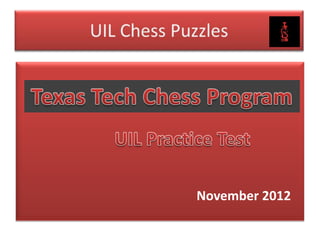
Uil chess puzzles (Practice Test)
- 2. • UIL Chess Puzzle Practice Material • This year’s UIL Chess Puzzle Test includes “solve the mate” positions similar to last year’s, but it also tests other kinds of chess knowledge—knowledge that relates directly to other school skills. These skills include basic geometrical reasoning, computation, and problem solving . Developing critical and creative thinking. • Each test will still be 20 questions, and one point will be given for each correct answer. No deductions will be made for incorrect answers. Students will be given 30 minutes to complete the test. Finishing early is not rewarded.
- 3. • Tie-breaking procedures have been changed. Tie breaks will now be decided by a more difficult text of 20 questions for which students have only 10 minutes. Incorrect answers are penalized by subtracting 1.25 from the final score. So, on the tie-break test, it’s smart to be sure of an answer instead of racing to circle answers to all the questions. • Below are some study guides and sample questions that reflect the general approach of this year’s UIL Chess Puzzle Test (not the tie-breaking test, which will have a higher degree of difficulty)>
- 4. • How to answer questions on the test. • In order to answer most of the 20 questions on this test, you’ll need to know how “to read and write chess.” The system is called “algebraic notation,” or “AN” for short. It’s simple and depends on two easy systems, one for the board and one for the pieces. • Every square on the board has an “address” made up of a letter and a number.
- 5. Every pieces is indicated by a logical abbreviation: King K Queen Q Rook R Bishop B Knight N (because “K” is already taken by the King!) Pawn (the file it’s on) (a-h)
- 6. The United States Chess Federation offers a concise and complete explanation here: http://archive.uschess.org/beginners/read Of course, you will also need to know how the pieces move. For a short but comprehensive course in moving the chess pieces, go to the U.S. Chess Federation site: http://archive.uschess.org/beginners/letsplay.pdf Now answer each of the questions below. Be sure to read the question carefully and then choose the letter of the single, best answer from the choices below each question.
- 7. UIL Chess Puzzles 1- What squares can the White pawn in the diagram move to? 8 a) e3, e4 and exd3 7 b) Only e4 6 c) d3 and f3 5 d) e1 and d4 4 3 2 1 A B C D E F G H
- 8. UIL Chess Puzzles 2- The chessboard has how many squares? a) 32 b) 64 c) 72 d) None of the above
- 9. UIL Chess Puzzles 3- Chess Players have names for three kinds of “Streets” on a chessboard made by connecting squares. Which kind of “streets” do Bishops travel on? a) Ranks b) Files c) Rows d) Diagonals
- 10. UIL Chess Puzzles 4- White just played e2-e4, is it possible for Black to capture the White pawn next? a) Yes b) No
- 11. 5- White to move and win a) xe7 b) e1 c) a1 d) d8
- 12. UIL Chess Puzzles 6- Which side has the greater value of material left on the board? a) White b) Black c) Equal material d) Unclear
- 13. 7- White to move and win a) e7 b) xd3 c) h6 d) xd8
- 14. UIL Chess Puzzles 8- What move checkmates Black immediately? a) d7 b) c8 c) c1 d) c3
- 15. UIL Chess Puzzles 9- The Bishop is a very strong piece. In open games, the Bishop is powerful do to its long-scope mobility. In the next diagram, find the Bishop move to stop three pawns from queening. a) a4 b) c6 c) d7 d) e8
- 16. 10- White to move and win a) g2 b) g1 c) xg7 d) b1
